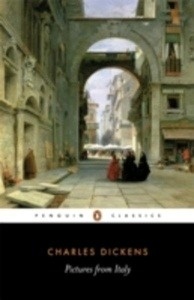Pictures from Italy

Editorial Penguin UK
Fecha de edición abril 2006
Idioma inglés
EAN 9780140434316
Libro
encuadernado en tapa blanda
Resumen del libro
A delightful travelogue in the unique style of one of the greatest writers in the English language, the "Penguin Classics" edition of Charles Dickens' "Pictures from Italy" is edited with notes and an introduction by and notes by Kate Flint. In 1844, Charles Dickens took a break from novel writing to travel through Italy for almost a year and "Pictures from Italy" is an illuminating account of his experiences there. He presents the country like a magic-lantern show, as vivid images ceaselessly appear before his - and his readers' - eyes.
Italy's most famous sights are all to be found here - St Peter's in Rome, Naples with Vesuvius smouldering in the background, the fairytale buildings and canals of Venice - but Dickens' chronicle is not simply that of a tourist. Avoiding preconceptions and stereotypes, he portrays a nation of great contrasts: between grandiose buildings and squalid poverty, and between past and present, as he observes everyday life beside ancient monuments. Combining thrilling travelogue with piercing social commentary, "Pictures from Italy" is a revealing depiction of an exciting and disquieting journey.
In her introduction, Kate Flint discusses nineteenth-century travel writing, and Dickens' ideas about perception, memory and Italian politics. This edition also includes a chronology, further reading, notes and an appendix. Charles Dickens is one of the best-loved novelists in the English language, whose 200th anniversary was celebrated in 2012.
His most famous books, including "Oliver Twist", "Great Expectations", "A Tale of Two Cities", "David Copperfield" and "The Pickwick Papers", have been adapted for stage and screen and read by millions. If you enjoyed "Pictures from Italy", you might like Dickens' "American Notes", also available in "Penguin Classics".
Biografía del autor
p Charles Dickens nació en Portsmouth en 1812, aunque pasó la mayor parte de su infancia en Londres y Kent. No empieza a acudir al colegio hasta los nueve años. Tras el encarcelamiento de su padre por el impago de deudas, su familia se traslada a la cárcel, ya que la legislación de la época permitía que los familiares compartieran la celda del moroso. El joven Dickens se ve obligado entonces a trabajar como operario en una factoría de betún para zapatos bajo duras condiciones laborales. Con el dinero que ganaba pagaba su propio hospedaje y ayudaba a su familia. Tras una formación prácticamente autodidacta, consiguió un puesto como secretario de un abogado en 1827, y poco después se convirtió en cronista parlamentario. Gracias a este oficio pudo publicar en 1833 su primera obra, i Esbozos /i , bajo el seudónimo de Boz. En esta línea continuó publicando, hasta que su obra i Los papeles póstumos del Club Pickwick /i lo convirtió en un autor aclamado mundialmente. Que la mayoría de su obra fuera publicada en entregas periódicas le daría gran popularidad e influencia entre el público inglés. Viajó por Europa y Estados Unidos, donde era muy conocido, aunque tras la crítica que realiza del Nuevo Mundo en su novela i Martin Chuzzlewit /i , se ve rechazado por la sociedad norteamericana. Entre sus obras más célebres se encuentran i Oliver Twist /i , i Canción de Navidad /i y, sobre todo, i David Copperfield /i , del que vendería en poco tiempo más de 100.000 ejemplares y que resume de modo magistral sus penurias infantiles. En el ámbito personal disfrutó de un fecundo matrimonio que le aportó diez hijos pero que finalmente se vio perturbado por las relaciones extramatrimoniales que Dickens mantenía con una actriz de teatro. Hombre enérgico y comprometido, compaginó su extensa labor literaria con otros campos de la cultura tales como la dramaturgia y la edición (fue fundador del semanario Household Words, donde publicaría por entregas dos de sus obras más conocidas, i Casa desolada /i y i Tiempos difíciles /i ). Administró diversas asociaciones caritativas y luchó por conseguir reformas sociales que favorecieran a las clases obreras, así como por la abolición de la esclavitud en Estados Unidos. Murió en Gadshill Place, el 9 de junio de 1870, tras sufrir una apoplejía. Fue incinerado, y sus restos reposan en la Esquina de los Poetas de la Abadía de Westminster.<br>








